8 Situational Judgement Tests Examples to Master in 2025
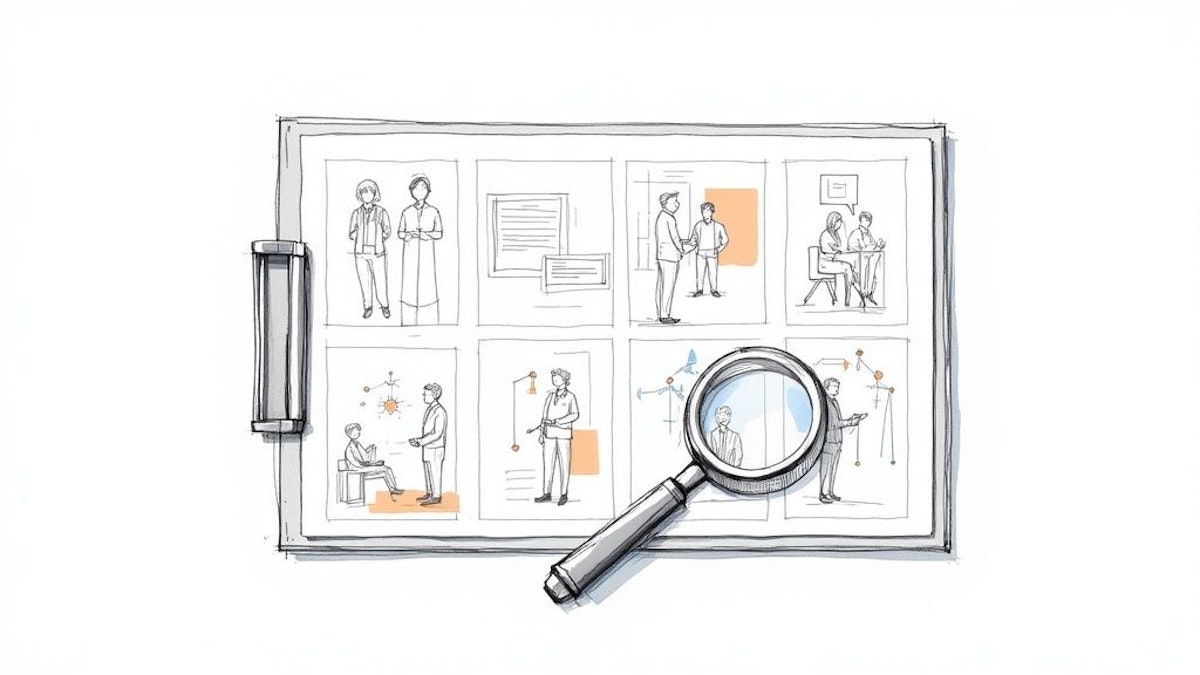
Situational Judgement Tests (SJTs) are a cornerstone of modern hiring, designed to evaluate how candidates handle real-world workplace scenarios. Unlike tests of pure knowledge, SJTs assess crucial soft skills, decision-making abilities, and alignment with company values. This focus on practical application is why they have become so prevalent; a meta-analysis by Clevenger, et al. (2001) published in the Journal of Applied Psychology found a positive correlation between high SJT scores and on-the-job performance, particularly in roles requiring strong interpersonal and problem-solving skills.
Understanding how to navigate these assessments is therefore critical for any job seeker. For a broader understanding of how SJTs fit within the wider scope of evaluating candidates, you can delve into other essential candidate assessment methods used by top companies.
This article provides a deep dive into 8 common situational judgement tests examples, moving beyond simple descriptions. We will dissect each scenario, analyze the multiple-choice options, and provide a detailed breakdown of the most effective responses. You will learn the underlying competencies being measured and gain actionable takeaways to demonstrate your professional judgment and prepare for your next assessment. Let's explore the examples.
1. Workplace Conflict Resolution
Workplace conflict resolution scenarios are a cornerstone of many situational judgement tests examples, designed to assess a candidate's interpersonal skills, emotional intelligence, and ability to navigate complex team dynamics. These questions present a realistic conflict between colleagues and ask the candidate to choose the most and least effective courses of action. The goal is to identify individuals who can de-escalate tensions, foster collaboration, and maintain a positive team environment, which are crucial skills for leadership and team-based roles.
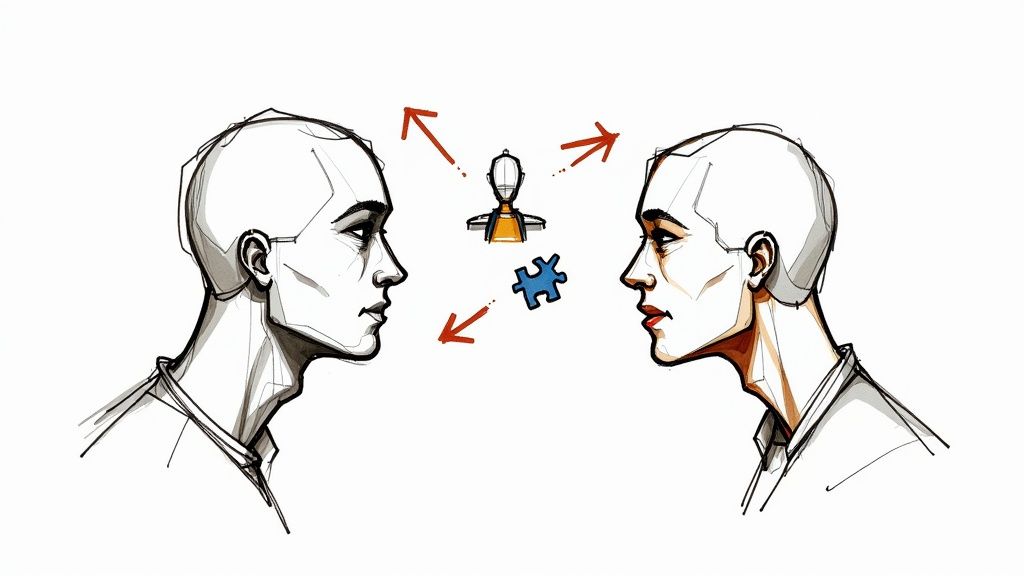
These scenarios are particularly prevalent in assessments for roles in healthcare, consulting, and technology project management where high-stakes decisions and diverse opinions are common. The effectiveness of these test items is supported by research indicating that how employees handle conflict directly impacts team performance and organizational health. For instance, a study by de Wit, Greer, and Jehn (2012) published in the Journal of Applied Psychology found that proactive and collaborative conflict management styles were positively associated with team effectiveness.
Strategic Breakdown
To excel in these scenarios, focus on responses that demonstrate a structured and empathetic approach. Your primary goal is not to "win" the argument but to facilitate a productive outcome.
- Prioritize Investigation: The best first step is always to gather more information. Avoid options that involve making assumptions or taking immediate action without understanding all sides of the issue.
- Encourage Direct Communication: Look for choices that involve bringing the conflicting parties together for a mediated, open conversation. This shows a commitment to transparency and mutual understanding.
- Seek Collaborative Solutions: The ideal resolution is one where both parties feel their primary concerns have been addressed. This is often referred to as a "win-win" outcome.
- Know When to Escalate: While autonomy is valued, the most effective responses also recognize the limits of one's authority. If the conflict involves serious policy violations or is beyond your ability to mediate, escalating to HR or a manager is the responsible choice.
By analyzing the options through this framework, you can consistently identify the most constructive and professional course of action. For a deeper dive into managing team disagreements, you can explore various workplace conflict resolution strategies.
2. Ethical Dilemma in Professional Settings
Ethical dilemmas are a critical component of many situational judgement tests examples, designed to evaluate a candidate's integrity, professional judgment, and ability to navigate morally ambiguous situations. These scenarios present a conflict between personal values, organizational policies, and professional responsibilities, requiring the candidate to choose the most and least ethical course of action. The objective is to identify individuals who demonstrate strong moral character and can uphold ethical standards, even under pressure.
These questions are frequently used in assessments for regulated industries such as finance, healthcare, law, and engineering, where ethical breaches can have severe consequences. The importance of this is underscored by data from the Ethics & Compliance Initiative's 2021 Global Business Ethics Survey®, which found that employees who feel pressure to compromise standards are far more likely to observe misconduct. SJTs help organizations proactively identify candidates who are less likely to bend to such pressures.
Strategic Breakdown
To succeed in these scenarios, you must demonstrate a principled and transparent decision-making process. The goal is to align your actions with both company policy and established professional codes of conduct.
- Reference Policies and Codes: The most effective responses are those grounded in official guidelines. Before acting, consider relevant company policies, industry regulations, or professional codes of conduct.
- Prioritize Transparency: Avoid options that involve concealing information or handling the situation quietly. Ethical conduct often requires open communication and documenting your actions.
- Consider All Stakeholders: Analyze how each potential action would impact all parties involved: the company, clients, colleagues, and the public. A strong answer protects the most vulnerable stakeholders and the organization's reputation.
- Seek Guidance When Unsure: The best responses show a willingness to consult with a supervisor, compliance department, or an ethics hotline when the correct path is unclear. This demonstrates humility and a commitment to doing the right thing.
By applying this framework, you can navigate complex ethical questions and select the response that best showcases your integrity and professional responsibility. For more insight into ethical frameworks, exploring resources like the Markkula Center for Applied Ethics can be beneficial.
3. Customer Service Crisis Management
Customer service crisis management scenarios are critical components in situational judgement tests examples, especially for client-facing roles. These questions are designed to evaluate a candidate's ability to handle high-pressure interactions with upset customers, respond to service failures, and protect the company's reputation. The test presents a challenging customer issue and asks the candidate to identify the most and least appropriate responses, revealing their problem-solving skills, empathy, and resilience under stress.
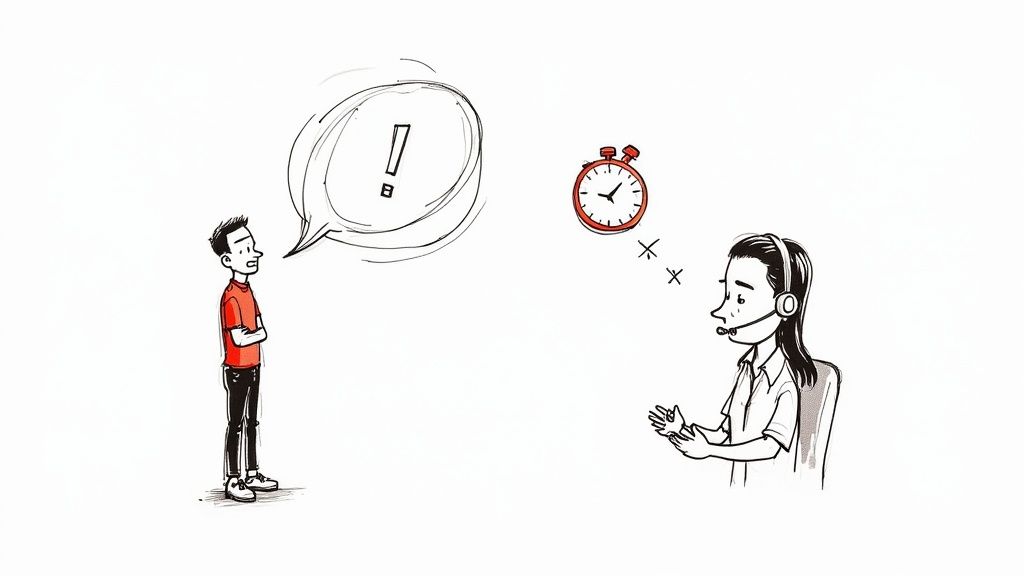
These scenarios are frequently used by companies where customer experience is paramount, across sectors like airlines, retail, and hospitality. The importance of these skills is well-documented; a 2018 global survey by PwC found that 73% of consumers point to experience as a key factor in their purchasing decisions. Therefore, identifying candidates who can effectively manage crises is a direct investment in customer loyalty and brand integrity. These tests help filter for individuals who can turn a negative experience into a positive one.
Strategic Breakdown
To succeed in customer crisis scenarios, your responses should demonstrate a commitment to resolving the issue while upholding professional standards. The focus is on de-escalation and finding a practical, satisfactory solution for the customer.
- Acknowledge and Empathize: The most effective first step is always to validate the customer's feelings. Options that begin with acknowledging their frustration or showing empathy are typically strong choices. Avoid defensive or dismissive language.
- Focus on Solutions, Not Blame: Immediately shift the conversation toward a solution. The best answers will involve taking ownership of the problem and outlining clear, actionable next steps. Do not waste time making excuses or blaming other departments.
- Communicate Clearly and Manage Expectations: Provide transparent information about what you can do and the expected timelines. Promising a quick fix that isn't possible is a poor choice. Clear communication builds trust even when the immediate outcome isn't ideal.
- Escalate When Necessary: Recognizing the limits of your authority is a sign of good judgment. If the customer's request is beyond your scope or requires specialist intervention, the most effective action is to escalate the issue to a supervisor or the correct department promptly.
4. Leadership Under Pressure
Leadership under pressure scenarios are critical components of situational judgement tests examples, engineered to evaluate a candidate's decision-making, resilience, and strategic thinking in high-stakes environments. These questions simulate crises like budget cuts, tight deadlines, or major organizational shifts, asking candidates to select the most and least effective actions. The objective is to identify individuals who can maintain composure, guide their teams effectively, and make sound judgments when faced with significant challenges, a vital skill for any management or leadership position.
These scenarios are frequently used in assessments for roles where crisis management is key, such as in military leadership programs, management consulting firms, and healthcare administration. The importance of this skill is well-documented; research from McKinsey & Company on organizational resilience suggests that leaders who demonstrate calmness and deliberate action during a crisis are significantly more effective at guiding their organizations through uncertainty. These test items measure precisely that capability.
Strategic Breakdown
To succeed in these scenarios, you must demonstrate a calm, methodical, and people-centric approach to problem-solving. Your focus should be on stabilizing the situation while upholding team morale and maintaining progress toward key objectives.
- Gather All Available Information: The best responses begin with a thorough assessment of the situation. Avoid options that involve knee-jerk reactions or making critical decisions without a complete picture.
- Communicate Clearly and Transparently: Look for choices that emphasize open communication with all stakeholders. Keeping the team informed, even with difficult news, builds trust and prevents misinformation.
- Prioritize Based on Impact and Urgency: Effective leaders quickly identify the most critical tasks. Choose options that reflect a logical prioritization of actions that will mitigate the most significant risks or have the greatest positive impact.
- Delegate Appropriately and Maintain Accountability: The most effective leaders empower their teams. Favorable answers involve delegating tasks to capable team members while ensuring clear ownership and maintaining ultimate accountability for the outcome. For more insights, you can explore the role of what is emotional intelligence in leadership.
5. Team Collaboration and Communication
Team collaboration and communication scenarios are fundamental components of modern situational judgement tests examples, built to assess a candidate's ability to integrate into a team, share information effectively, and contribute to a collective goal. These questions typically place the candidate within a project team and challenge them with issues like misaligned priorities, poor information flow, or disagreements on approach. The objective is to identify individuals who can foster a cohesive and productive team environment, a skill highly valued in today's interconnected workplaces.
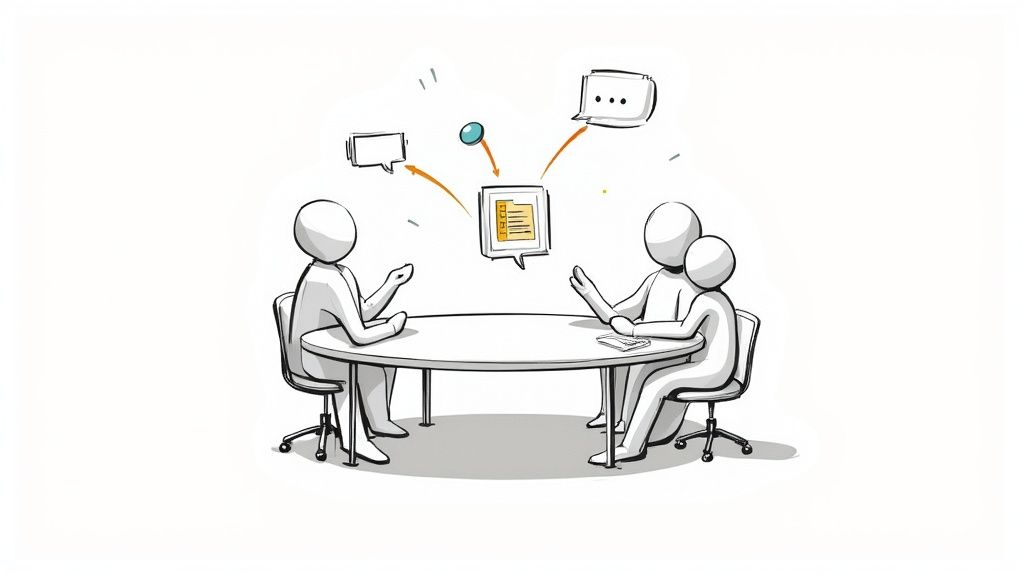
These scenarios are frequently used by technology firms, where agile methodologies demand seamless collaboration, and by consulting firms where project success hinges on teamwork. The focus on collaboration is backed by extensive research. A landmark literature review by Salas, Sims, and Burke (2005) published in American Psychologist highlighted that successful collaboration is a key predictor of organizational performance and that competencies like mutual support and communication are critical to team effectiveness. These tests provide a standardized way to measure this crucial competency.
Strategic Breakdown
To succeed in these scenarios, demonstrate a proactive and inclusive mindset. The best choices will always prioritize the team's shared goals over individual preferences or siloed work habits.
- Establish Clear Channels: The most effective responses often involve creating or clarifying communication protocols. This could mean suggesting a daily stand-up meeting, a shared project document, or a dedicated communication channel to ensure everyone is aligned.
- Actively Seek Input: Look for options that show you value the contributions of all team members, regardless of their role or seniority. Actions like facilitating a brainstorming session or directly asking for a quiet colleague's opinion are highly favorable.
- Focus on Shared Goals: The ideal course of action realigns the team around the project's ultimate objective. Responses that remind the team of their shared mission or mutual success are generally ranked as most effective.
- Address Issues Constructively: Avoid options that ignore or downplay emerging issues. The best approach is to address misunderstandings or process gaps early, openly, and with a focus on finding a practical solution rather than assigning blame.
By applying this framework, you can showcase your ability to be a unifying and effective team player. For a closer look at what makes a high-performing group, you can explore the characteristics of effective teams.
6. Time Management and Prioritization
Time management and prioritization scenarios are common situational judgement tests examples used to evaluate a candidate's organizational skills, strategic thinking, and ability to perform under pressure. These questions simulate a typical workday with competing deadlines, unexpected urgent tasks, and limited resources. The test assesses whether an individual can effectively distinguish between urgent and important activities, allocate their time efficiently, and communicate proactively about potential delays or resource constraints.
These scenarios are essential for evaluating candidates in fast-paced roles like project management, executive assistance, and emergency services. The ability to prioritize effectively is a strong predictor of job performance. The Project Management Institute's Pulse of the Profession® reports consistently show that poor time management is a leading cause of project failure, highlighting why employers screen for this competency. These SJT items identify candidates who can maintain productivity and quality without becoming overwhelmed.
Strategic Breakdown
To succeed in these scenarios, demonstrate a logical and strategic approach to task management. The goal is to show you can make informed decisions that align with broader organizational objectives, not just react to the most immediate demand.
- Apply a Prioritization Framework: The most effective responses often align with established models like the Eisenhower Matrix (Urgent/Important). Look for options that involve categorizing tasks based on their impact and deadline rather than tackling them chronologically.
- Focus on High-Impact Activities: Identify which tasks contribute most significantly to strategic goals. The best course of action is often to focus on an important, long-term project over a low-impact, urgent request.
- Communicate Proactively: Effective time managers keep stakeholders informed. Choose responses that involve communicating potential delays, clarifying priorities with a manager, or negotiating deadlines. Ignoring a problem is almost always the least effective option.
- Delegate When Appropriate: In leadership or team-based roles, the ability to delegate is key. If an option allows you to assign a task to a capable team member to manage your workload, it often represents a highly effective strategy.
7. Change management and Adaptability
Change management scenarios are critical components of modern situational judgement tests examples, crafted to measure a candidate's resilience, flexibility, and proactivity in the face of organizational shifts. These questions simulate real-world situations like new software implementations, policy updates, or strategic pivots. They assess a candidate's ability to not only cope with change but also to champion it, a vital skill in today's dynamic business environment. The objective is to identify individuals who can maintain performance, support their colleagues, and find opportunities amidst uncertainty.
These scenarios are frequently used in industries undergoing rapid transformation, such as technology, healthcare, and financial services. The importance of this competency is well-documented; a global survey from McKinsey & Company on organizational transformations found that the success of change initiatives is highly dependent on employees' positive attitudes and proactive behaviors. Assessors look for candidates who demonstrate a growth mindset and can effectively communicate the rationale and benefits of a change to their team, thereby mitigating resistance and fostering a smooth transition.
Strategic Breakdown
To succeed in change management scenarios, demonstrate a forward-thinking and supportive approach. Your goal is to show you are an enabler of change, not an obstacle.
- Seek to Understand First: The most effective responses show a desire to understand the "why" behind the change. Avoid options that display immediate resistance or skepticism. Instead, choose actions that involve seeking clarification from leadership or official sources.
- Communicate with Transparency: Prioritize options that involve open and honest communication with your team. Acknowledging challenges while focusing on the positive outcomes of the change shows strong leadership potential.
- Identify Opportunities: Top candidates look for the silver lining. Frame the change as a chance for growth, learning new skills, or improving processes. This proactive stance is highly valued.
- Support and Empower Others: The best answers involve helping colleagues navigate the transition. This could mean offering training, listening to concerns, or sharing best practices for adapting to the new way of working.
By applying this strategic lens, you can consistently select responses that showcase adaptability and leadership, proving you can thrive in an evolving workplace.
8. Risk Assessment and Decision Making
Risk assessment scenarios are critical components of situational judgement tests examples, especially for roles that demand foresight, analytical rigor, and accountability. These questions present complex situations with incomplete information, requiring candidates to evaluate potential risks, weigh costs and benefits, and make sound decisions under uncertainty. The objective is to identify individuals who can navigate ambiguity and consider the long-term consequences of their choices for multiple stakeholders, a vital skill in finance, healthcare, and engineering.
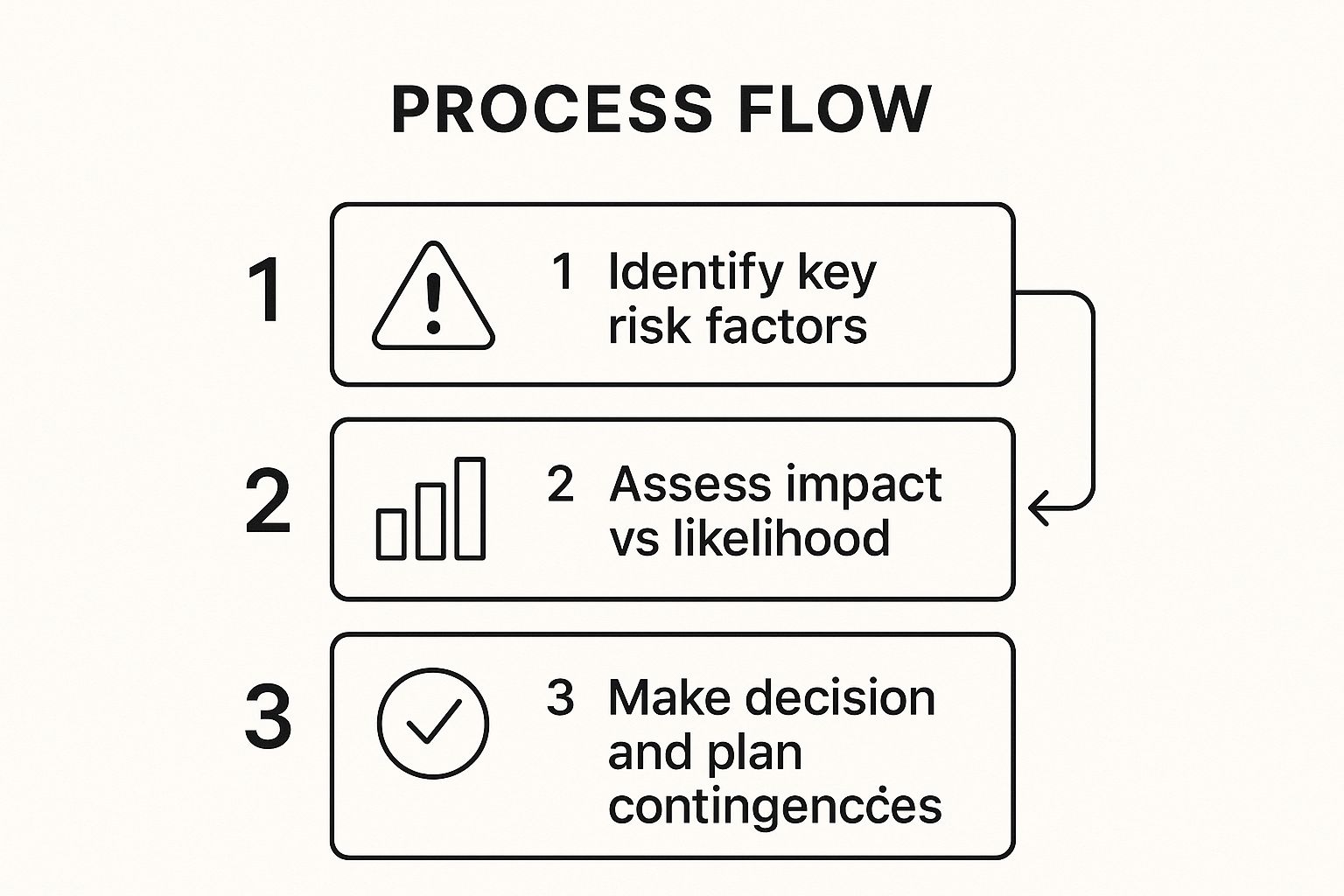
These scenarios are frequently used by financial services firms for investment roles and consulting companies for strategic advisory positions. Their relevance is supported by behavioral economics research, such as the work by Kahneman and Tversky, which demonstrates how cognitive biases can impair decision-making under risk. For example, a meta-analysis in the Journal of Behavioral Decision Making (Harbaugh, et al., 2010) highlighted that structured assessment frameworks significantly improve the quality of decisions in uncertain environments. The infographic above illustrates a simplified three-step process for structured risk assessment, a method often tested in these scenarios. Following a systematic approach like this helps mitigate bias and ensures a more thorough evaluation.
Strategic Breakdown
To succeed in risk assessment scenarios, demonstrate a methodical and evidence-based approach. The key is to show you can balance caution with decisive action, rather than acting impulsively or being paralyzed by uncertainty.
- Identify and Quantify Risks: The best responses involve systematically identifying the key risk factors. Avoid options that downplay or ignore potential negative outcomes.
- Seek Critical Information: Look for choices that involve gathering more data to fill crucial information gaps before committing to a final decision. This shows diligence and an analytical mindset.
- Consider Long-Term Consequences: Effective decision-makers think beyond immediate gains. Prioritize options that consider the long-term impact on all stakeholders, including clients, the company, and the public.
- Plan for Contingencies: The most robust solutions include a plan B. Choose options that involve creating contingency plans or monitoring mechanisms to manage the outcomes of the decision.
By applying this strategic framework, you can showcase your ability to make well-reasoned judgments. To further develop these skills, you can explore detailed information on the assessment of critical thinking.
Situational Judgement Test Examples Comparison
| Scenario | Implementation Complexity 🔄 | Resource Requirements ⚡ | Expected Outcomes 📊 | Ideal Use Cases 💡 | Key Advantages ⭐ |
|---|---|---|---|---|---|
| Workplace Conflict Resolution | Moderate: Requires nuanced evaluation | Moderate: Skilled evaluators for subjective scoring | Improved interpersonal skills, leadership potential | Team-based roles, cross-industry, client-facing positions | Tests soft skills, predicts teamwork and leadership |
| Ethical Dilemma in Professional Settings | High: Complex moral reasoning required | Moderate: Expert scenario design and evaluation | Identification of integrity, risk reduction in ethics | Compliance-heavy industries, regulatory, client advisory roles | Assesses values alignment, reduces ethical violations |
| Customer Service Crisis Management | Moderate: Time-sensitive, scenario variability | Moderate: Simulation tools and trained evaluators | Enhanced stress management and service recovery | Customer-facing roles in retail, airlines, banking, telecom | Tests emotional regulation, predicts crisis handling |
| Leadership Under Pressure | High: Multi-layered decisions and resource juggling | High: Requires scenario customization and expertise | Identification of leadership and strategic decision skills | Executive, management, military, healthcare admin roles | Evaluates strategic thinking and team management |
| Team Collaboration and Communication | Moderate: Focus on interpersonal dynamics | Moderate: Requires diverse team simulations | Improved communication and teamwork | Cross-functional projects, agile teams, research, marketing | Tests interpersonal, inclusivity, and communication skills |
| Time Management and Prioritization | Low to Moderate: Clear task prioritization challenges | Low: Standardized scenarios and scoring | Practical organizational skills, stress management | Most professional roles requiring deadline and multitasking management | Tests prioritization, predicts performance under pressure |
| Change Management and Adaptability | Moderate: Requires scenario updates as changes evolve | Moderate: Needs contextual organizational scenarios | Enhanced flexibility, resilience, and communication | Fast-evolving industries, digital transformation, healthcare, retail | Assesses adaptability and growth mindset |
| Risk Assessment and Decision Making | High: Complex analysis with incomplete info | High: Needs expert scenario design and analytical tools | Improved critical thinking and risk management | Strategic, financial, engineering, healthcare decision-making roles | Tests analytical skills, decision-making under uncertainty |
From Theory to Practice: Applying SJT Insights for Hiring Success
The situational judgement tests examples we have explored reveal a powerful truth about modern hiring: technical skills are only one part of the equation. From navigating workplace conflicts to managing customer crises and leading under pressure, the ideal candidate possesses a robust blend of emotional intelligence, ethical integrity, and strategic problem-solving abilities. These are the competencies that truly predict on-the-job success and long-term cultural alignment.
By deconstructing these scenarios, we have moved beyond simply identifying the "right" answer. Instead, we have uncovered the underlying principles that separate an adequate response from an exceptional one. The key is not just what a candidate would do, but why they would do it, revealing their core motivations and alignment with professional best practices.
Key Strategic Takeaways
As you integrate these insights into your hiring process, remember these core principles:
- Context is King: The most effective SJTs are not generic. They are tailored to reflect the specific challenges, values, and communication styles of your organization. A scenario that is critical for a fast-paced tech startup may be irrelevant for a regulated financial institution.
- Focus on the "Why": The real value of an SJT lies in understanding a candidate's reasoning. The explanations behind their choices offer a deeper look into their problem-solving approach, ethical framework, and interpersonal skills than a simple multiple-choice answer ever could.
- Balance Realism with Clarity: Scenarios should be realistic enough to be challenging but clear enough to avoid ambiguity. The goal is to test judgment, not to trick the candidate with poorly worded or confusing situations.
Actionable Next Steps for Your Hiring Team
Moving from theory to application requires a structured approach. To elevate your talent acquisition strategy, consider the following actions:
- Audit Your Current Process: Review your existing interview questions and assessments. Are you effectively measuring the soft skills and situational judgment critical for success in your key roles?
- Define Core Competencies: Collaborate with department heads to identify the top 3-5 situational competencies required for each role. This could range from conflict resolution for managers to adaptability for junior team members.
- Develop Custom Scenarios: Use the situational judgement tests examples in this article as a template to build your own scenarios. Ground them in real-world challenges your teams have faced to ensure relevance and predictive power. These tailored assessments provide critical data for effective candidate profiling, creating a holistic view of each applicant.
By systematically embedding SJTs into your hiring framework, you create a more reliable, equitable, and insightful process. You move beyond resumes and interviews to see how candidates think, act, and align with the very essence of your company culture, building a foundation for a more engaged and high-performing workforce.
Ready to build custom SJTs that reflect your unique culture and predict performance? See how MyCulture.ai transforms theory into practice with science-backed, customizable assessments. Create your first situational judgement test today at MyCulture.ai.